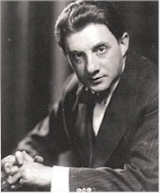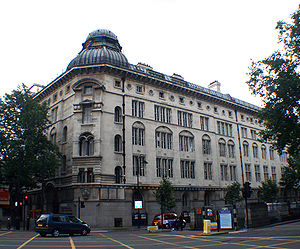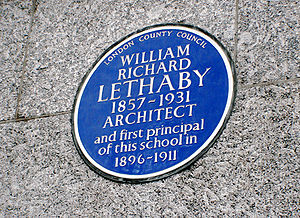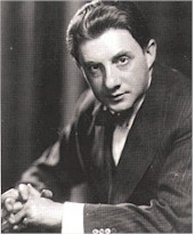
Southampton Row
Encyclopedia




Bloomsbury, London
Bloomsbury is an area of central London between Euston Road and Holborn, developed by the Russell family in the 17th and 18th centuries into a fashionable residential area. It is notable for its array of garden squares, literary connections and numerous cultural, educational and healthcare...
, Camden
London Borough of Camden
In 1801, the civil parishes that form the modern borough were already developed and had a total population of 96,795. This continued to rise swiftly throughout the 19th century, as the district became built up; reaching 270,197 in the middle of the century...
, central London
London
London is the capital city of :England and the :United Kingdom, the largest metropolitan area in the United Kingdom, and the largest urban zone in the European Union by most measures. Located on the River Thames, London has been a major settlement for two millennia, its history going back to its...
, England
England
England is a country that is part of the United Kingdom. It shares land borders with Scotland to the north and Wales to the west; the Irish Sea is to the north west, the Celtic Sea to the south west, with the North Sea to the east and the English Channel to the south separating it from continental...
. The road is designated as part of the A4200.
Location
To the north, Southampton Row adjoins the southeast corner of Russell SquareRussell Square
Russell Square is a large garden square in Bloomsbury, in the London Borough of Camden. It is near the University of London's main buildings and the British Museum. To the north is Woburn Place and to the south-east is Southampton Row...
. To the south at Holborn tube station
Holborn tube station
Holborn is a station of the London Underground in Holborn in London, located at the junction of High Holborn and Kingsway. Situated on the Piccadilly Line and on the Central Line , it is the only station common to the two lines, although the two lines cross each other three times elsewhere...
, it becomes Kingsway
Kingsway (London)
Kingsway is a major road in central London in the United Kingdom, designated as part of the A4200. It runs from High Holborn, at its north end in the London Borough of Camden, and meets Aldwych in the south in the City of Westminster at Bush House. It was built in the 1900s...
at the junction with High Holborn
High Holborn
High Holborn is a road in Holborn in central London, England. It starts in the west near St Giles Circus, then goes east, past the Kingsway and Southampton Row, and continues east. The road becomes Holborn at the junction with Gray's Inn Road....
.
On the corner with Theobald's Road (part of the A401) is Central Saint Martins College of Art and Design
Central Saint Martins College of Art and Design
Central Saint Martins College of Art and Design is a constituent college of the University of the Arts London. The school has an outstanding international reputation, and is considered one of the world's leading art and design institutions...
and the Cochrane Theatre
Cochrane Theatre
The Cochrane Theatre is a receiving and producing theatre that aims to present all aspects of the performing arts within a proscenium arch. The theatre is situated in Holborn, London.-History:...
. There are several major hotels on Southampton Row, including the Bedford, Bonnington and Holborn hotels.
History
The street was named after Thomas Wriothesley, 4th Earl of SouthamptonThomas Wriothesley, 4th Earl of Southampton
Sir Thomas Wriothesley, 4th Earl of Southampton, KG , styled Lord Wriothesley before 1624, was a 17th century English statesman, a staunch supporter of Charles II who would rise to the position of Lord High Treasurer after the English Restoration...
. It was previously known as Kingsgate Street.
In 1822, the Chartist
Chartism
Chartism was a movement for political and social reform in the United Kingdom during the mid-19th century, between 1838 and 1859. It takes its name from the People's Charter of 1838. Chartism was possibly the first mass working class labour movement in the world...
Henry Hetherington
Henry Hetherington
Henry Hetherington was a leading British Chartist.- Early years :Henry Hetherington was the son of a London tailor, John Hetherington , and was born on 17 June 1792, at 16 Compton Street, Soho, London...
registered a printing press at 13 Kingsgate Street, an eight-roomed house, including shop and printing premises, at an annual rent of £55.
The first studio of the sculptor Robert William Sievier
Robert William Sievier
Robert William Sievier FRS was a notable English engraver, sculptor and later inventor of the 19th century.-Engraver and sculptor:...
(1794–1865) was in Southampton Row until 1837.
The Central School of Art and Design, formerly the Central School of Arts and Crafts, was established by the London County Council
London County Council
London County Council was the principal local government body for the County of London, throughout its 1889–1965 existence, and the first London-wide general municipal authority to be directly elected. It covered the area today known as Inner London and was replaced by the Greater London Council...
in 1896 in Southampton Row to provide specialist art teaching for workers in the craft industries. The architect William Lethaby
William Lethaby
William Richard Lethaby was an English architect and architectural historian whose ideas were highly influential on the late Arts and Crafts and early Modern movements in architecture, and in the fields of conservation and art education.-Early life:Lethaby was born in Barnstaple, Devon, the son of...
(1857–1931) was the first Principal, as recorded by a blue plaque
Blue plaque
A blue plaque is a permanent sign installed in a public place to commemorate a link between that location and a famous person or event, serving as a historical marker....
on Southampton Row.
Sir John Barbirolli
John Barbirolli
Sir John Barbirolli, CH was an English conductor and cellist. Born in London, of Italian and French parentage, he grew up in a family of professional musicians. His father and grandfather were violinists...
, the conductor and cellist, was born in Southampton Row on 2 December 1899. A commemorative blue plaque
Blue plaque
A blue plaque is a permanent sign installed in a public place to commemorate a link between that location and a famous person or event, serving as a historical marker....
was placed on the wall of the Bloomsbury Park Hotel in May 1993 to mark his birthplace.
In 1907, the Institute of Education
Institute of Education
The Institute of Education is a public research university located in London, United Kingdom specialised in postgraduate study and research in the field of education and a constituent college of the federal University of London. It is the largest education research body in the United Kingdom, with...
moved to its first purpose built building on Southampton Row. In 1938, the Institute moved to the Senate House complex
Senate House (University of London)
Senate House is the administrative centre of the University of London, situated in the heart of Bloomsbury, London between the School of Oriental and African Studies to the north, with the British Museum to the south...
of the University of London
University of London
-20th century:Shortly after 6 Burlington Gardens was vacated, the University went through a period of rapid expansion. Bedford College, Royal Holloway and the London School of Economics all joined in 1900, Regent's Park College, which had affiliated in 1841 became an official divinity school of the...
on Malet Street
Malet Street
Malet Street is a street in Bloomsbury, in the London Borough of Camden, central London, England. It runs between Torrington Place and the British Museum, parallel to Gower Street and Tottenham Court Road...
, not far away to the northwest.
The Sue Ryder Care
Sue Ryder Care
Sue Ryder is a charity which was founded in 1953 by Sue Ryder, with the creation of a nursing home in Suffolk, UK....
charity, established in 1953, is registered at 114–118 Southampton Row.
In 1966, the Indica Bookshop was separated from the Indica Gallery
Indica Gallery
Indica Gallery was a counterculture art gallery in Mason's Yard , St. James's, London, England during the late 1960s, in the basement of the Indica Bookshop co-owned by John Dunbar, Peter Asher and Barry Miles...
, a counterculture art gallery supported by Paul McCartney
Paul McCartney
Sir James Paul McCartney, MBE, Hon RAM, FRCM is an English musician, singer-songwriter and composer. Formerly of The Beatles and Wings , McCartney is listed in Guinness World Records as the "most successful musician and composer in popular music history", with 60 gold discs and sales of 100...
, and moved to 102 Southampton Row in the summer of that year.
The street formed part of a tram
Tram
A tram is a passenger rail vehicle which runs on tracks along public urban streets and also sometimes on separate rights of way. It may also run between cities and/or towns , and/or partially grade separated even in the cities...
route, including a tunnel for trams. Nowadays it is a major bus route in central London
Central London
Central London is the innermost part of London, England. There is no official or commonly accepted definition of its area, but its characteristics are understood to include a high density built environment, high land values, an elevated daytime population and a concentration of regionally,...
.

